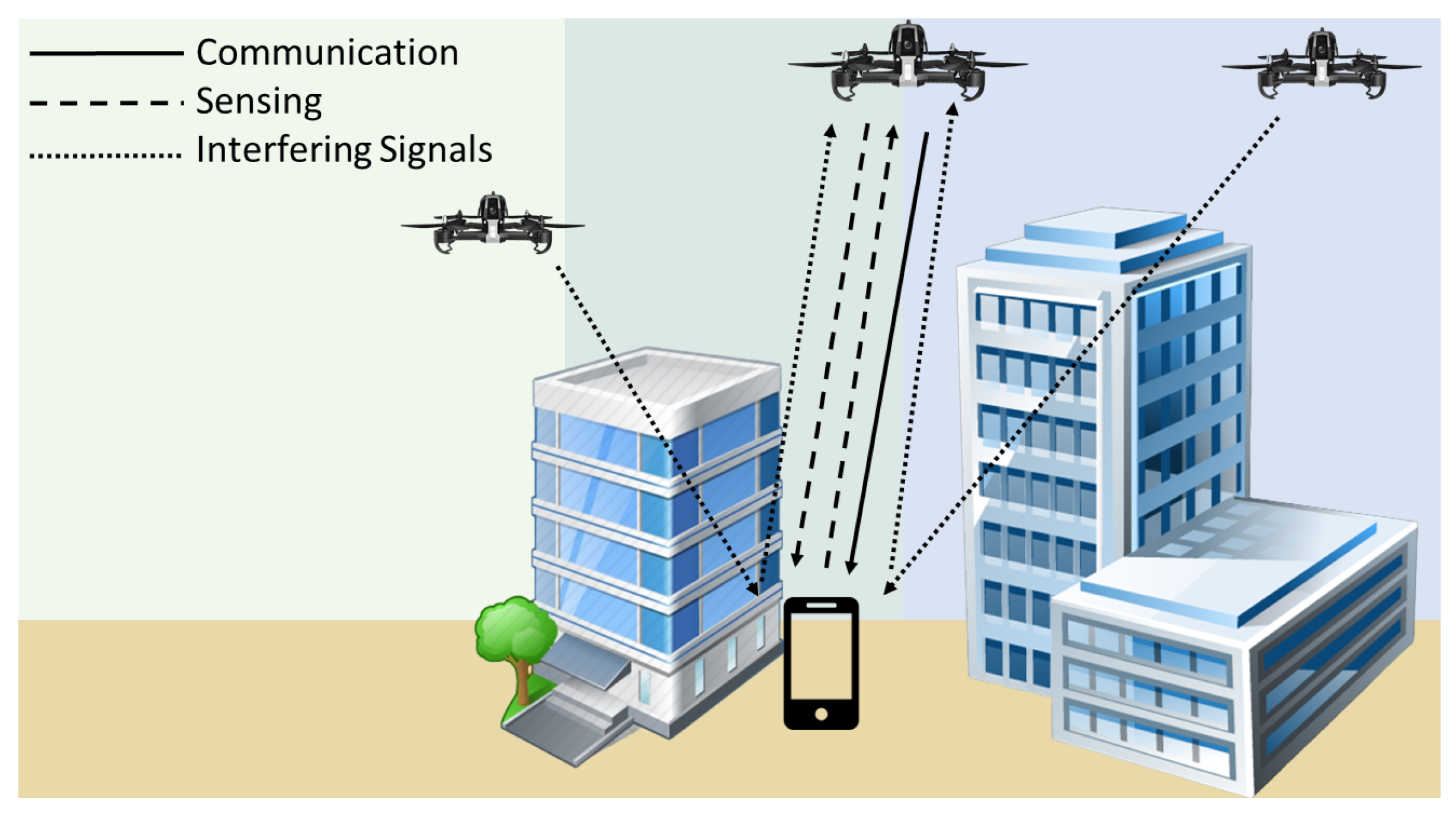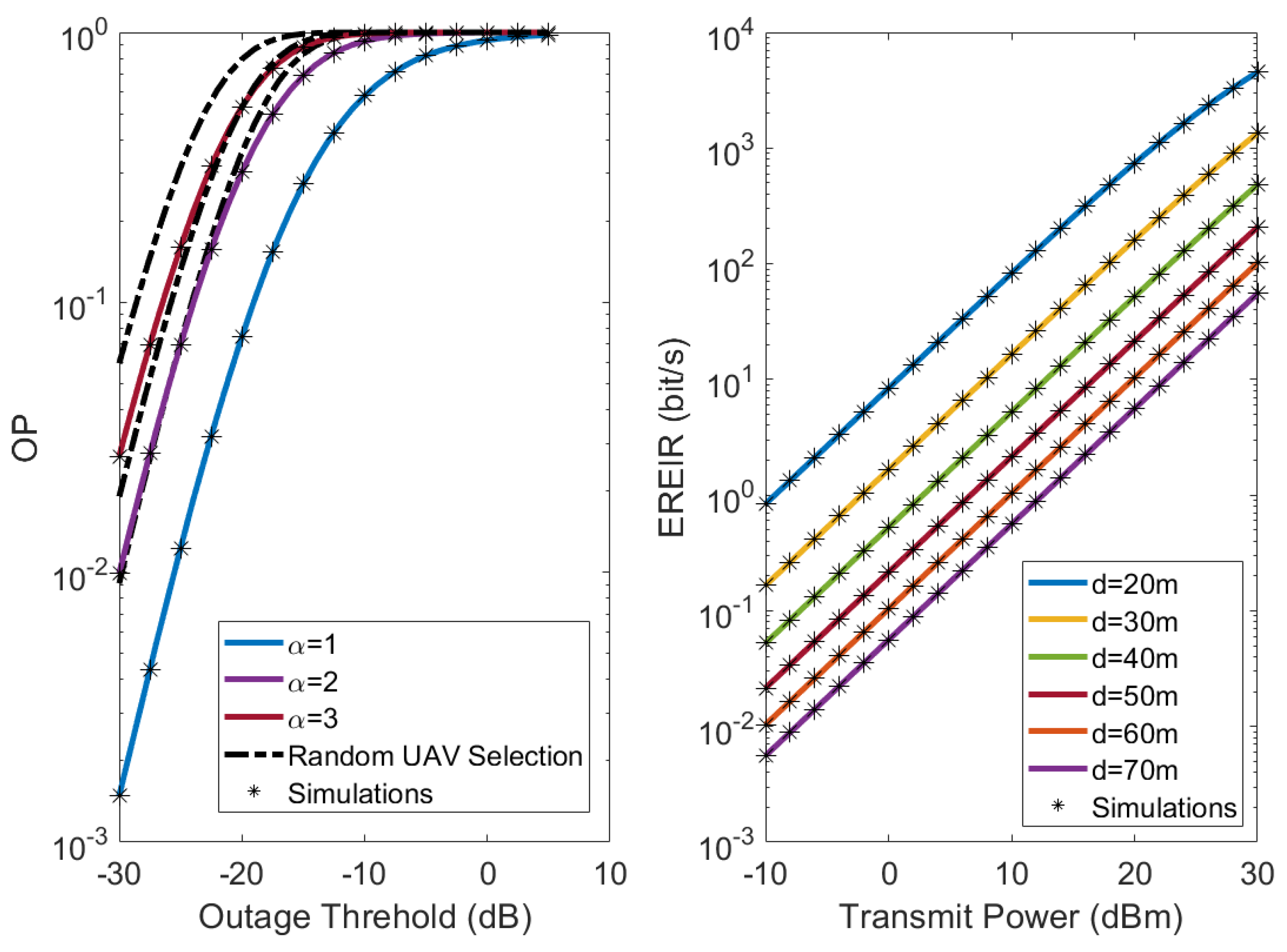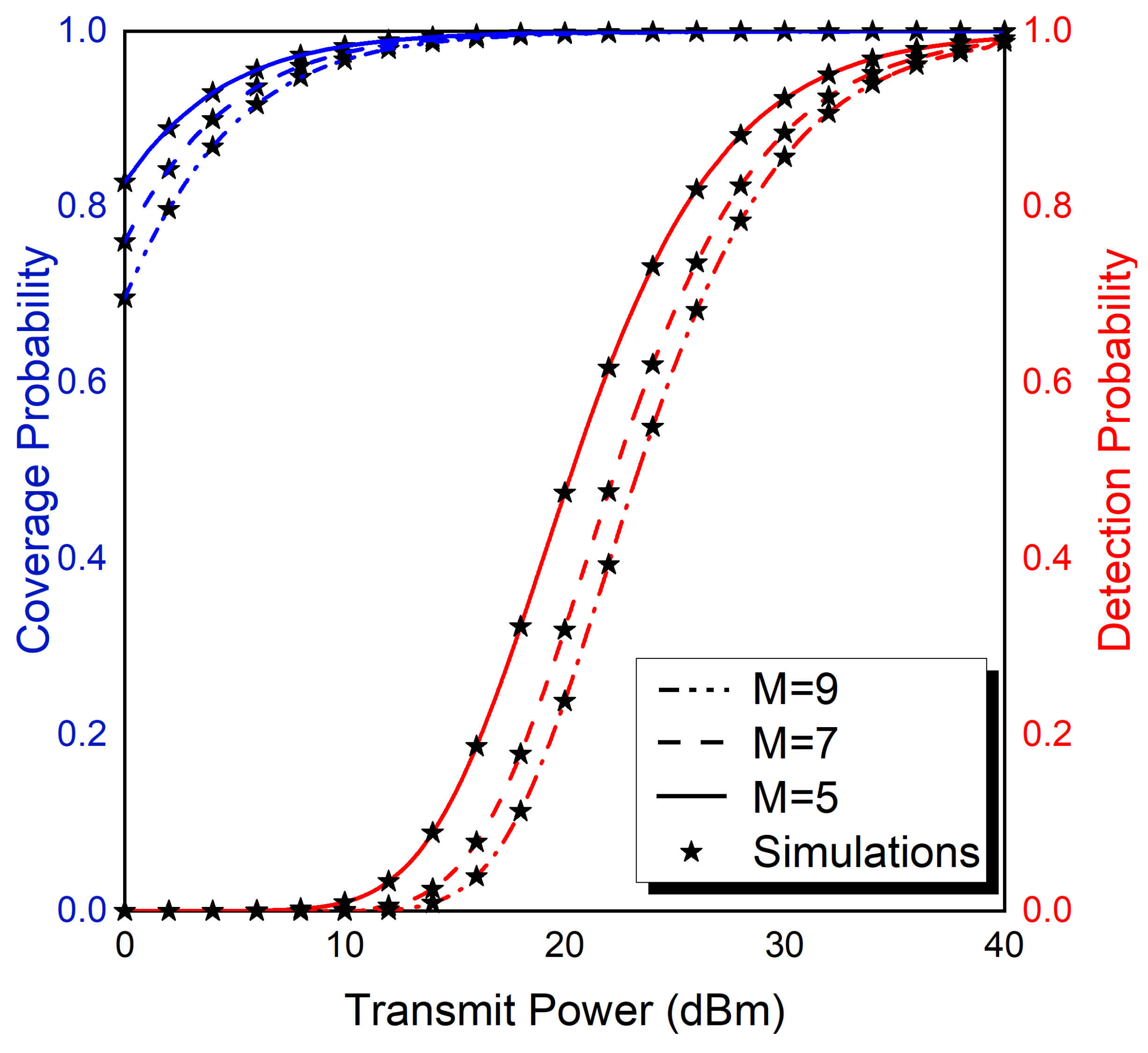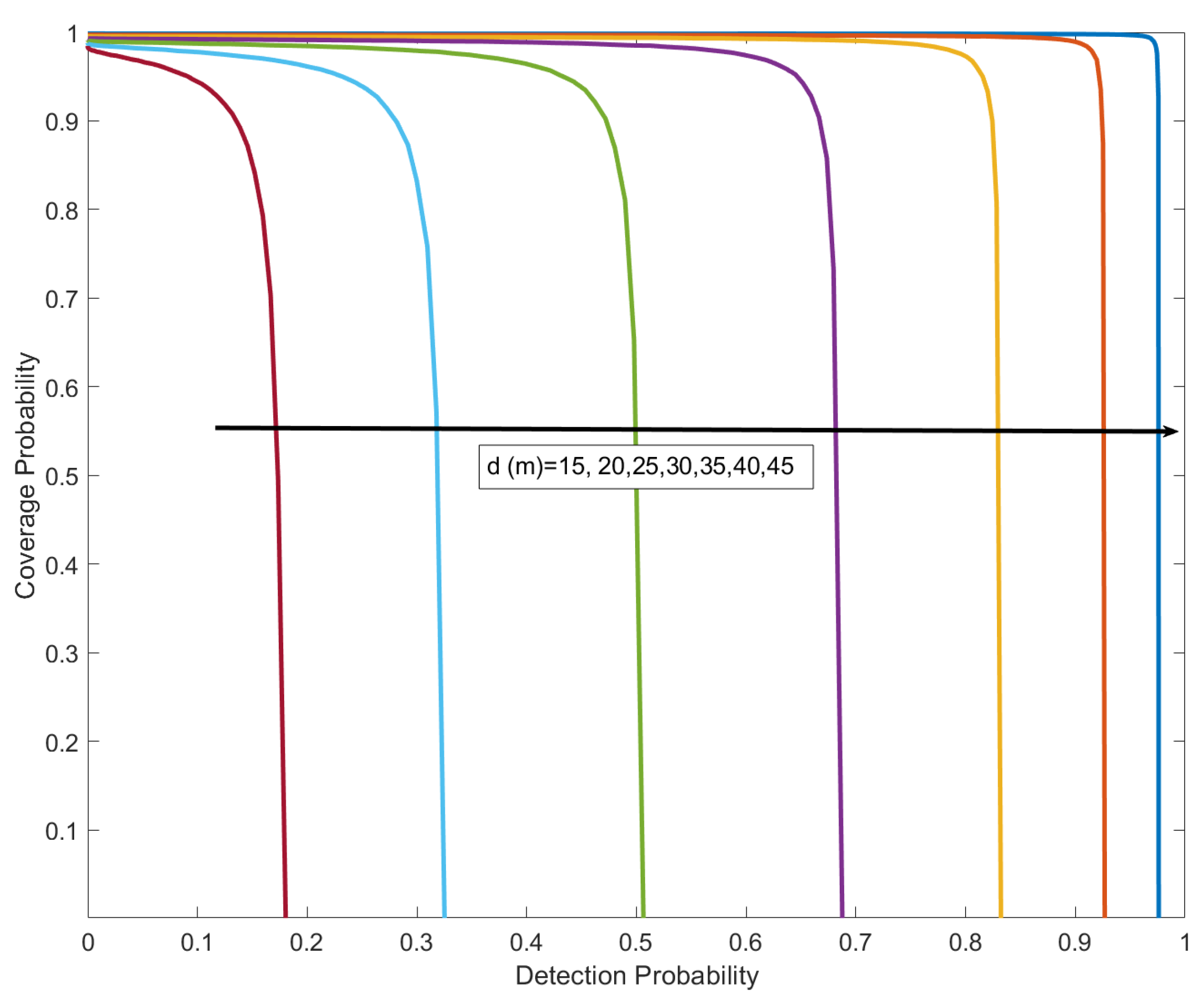Submitted:
30 September 2024
Posted:
30 September 2024
You are already at the latest version
Abstract
Keywords:
1. Introduction
2. System and Channel Models
2.1. Channel Model
2.2. Communication Model
2.3. Sensing Model
3. Performance Analysis
3.1. Communication Operation
3.2. Sensing Operation
3.3. Performance Trade-Off
4. Numerical Results
5. Conclusions
Author Contributions
Funding
Conflicts of Interest
Abbreviations
| CDF | Cumulative distribution function |
| CP | Coverage probability |
| DP | Detection probability |
| EREIR | Ergodic radar estimation information rate |
| ISAC | Integrate sensing and communication |
| JSAC | Joint sensing and communication |
| OP | Outage probability |
| Probability density function | |
| SIR | Signal to interference ratio |
| SNR | Signal to noise ratio |
| UAV | Unammned aerial vehicle |
Appendix A. Statistics of the Sum of Gamma RVs
Appendix B. Statistics of the Maximum of Inverse Gamma RVs
References
- Bithas, P.S.; Efthymoglou, G.P.; Kanatas, A.G.; Maliatsos, K. UAV Selection in Aerial Integrated Sensing and Communication Networks. In Proceedings of the IEEE 100th Vehicular Technology Conference (VTCFall); 2024. [Google Scholar]
- Wild, T.; Braun, V.; Viswanathan, H. Joint design of communication and sensing for beyond 5G and 6G systems. IEEE Access 2021, 9, 30845–30857. [Google Scholar] [CrossRef]
- Xiao, Z.; Zeng, Y. Waveform Design and Performance Analysis for Full-Duplex Integrated Sensing and Communication. IEEE J. Sel. Areas Commun. 2022, 40, 1823–1837. [Google Scholar] [CrossRef]
- Liu, M.; Yang, M.; Li, H.; Zeng, K.; Zhang, Z.; Nallanathan, A.; Wang, G.; Hanzo, L. Performance analysis and power allocation for cooperative ISAC networks. IEEE Internet Things J. 2022, 10, 6336–6351. [Google Scholar] [CrossRef]
- Liu, M.; Yang, M.; Zhang, Z.; Li, H.; Liu, F.; Nallanathan, A.; Hanzo, L. Sensing-Communication Coexistence vs. Integration. IEEE Trans. Veh. Technol. 2023, 72, 8158–8163. [Google Scholar] [CrossRef]
- Li, X.; Guo, S.; Li, T.; Zou, X.; Li, D. On the Performance Trade-Off of Distributed Integrated Sensing and Communication Networks. IEEE Wirel. Commun. Lett. 2023, 12, 2033–2037. [Google Scholar] [CrossRef]
- Meng, K.; Masouros, C.; Chen, G.; Liu, F. BS Coordination Optimization in Integrated Sensing and Communication: A Stochastic Geometric View. arXiv preprint arXiv:2401.04918, arXiv:2401.04918 2024.
- Wu, Q.; Xu, J.; Zeng, Y.; Ng, D.W.K.; Al-Dhahir, N.; Schober, R.; Swindlehurst, A.L. A comprehensive overview on 5G-and-beyond networks with UAVs: From communications to sensing and intelligence. IEEE Journal on Selected Areas in Communications 2021, 39, 2912–2945. [Google Scholar] [CrossRef]
- Zhang, Y.; Shan, H.; Chen, H.; Mi, D.; Shi, Z. Perceptive mobile networks for unmanned aerial vehicle surveillance: From the perspective of cooperative sensing. IEEE Vehicular Technology Magazine 2024. [Google Scholar] [CrossRef]
- Chen, X.; Feng, Z.; Wei, Z.; Gao, F.; Yuan, X. Performance of joint sensing-communication cooperative sensing UAV network. IEEE Transactions on Vehicular Technology 2020, 69, 15545–15556. [Google Scholar] [CrossRef]
- Tropkina, I.; Sun, B.; Moltchanov, D.; Pyattaev, A.; Tan, B.; Dinis, R.; Andreev, S. Distributed communication and sensing system co-design for improved UAV network resilience. IEEE Transactions on Vehicular Technology 2022, 72, 924–939. [Google Scholar] [CrossRef]
- Fei, Z.; Wang, X.; Wu, N.; Huang, J.; Zhang, J.A. Air-ground integrated sensing and communications: Opportunities and challenges. IEEE Communications Magazine 2023, 61, 55–61. [Google Scholar] [CrossRef]
- Mei, M.; Yao, M.; Yang, Q.; Wang, J.; Jing, Z.; Quek, T.Q. Network-layer Delay Provisioning for Integrated Sensing and Communication UAV Networks under Transient Antenna Misalignment. IEEE Transactions on Wireless Communications 2024. [Google Scholar] [CrossRef]
- Bithas, P.S.; Nikolaidis, V.; Kanatas, A.G.; Karagiannidis, G.K. UAV-to-Ground communications: Channel modeling and UAV selection. IEEE Trans. Commun. 2020, 68, 5135–5144. [Google Scholar] [CrossRef]
- Simon, M.K.; Alouini, M.S. Digital Communication over Fading Channels, 2 ed.; Wiley: New York, 2005. [Google Scholar]
- Gradshteyn, I.S.; Ryzhik, I.M. Table of Integrals, Series, and Products, 6 ed.; Academic Press: New York, 2000. [Google Scholar]
- Al-Hourani, A.; Kandeepan, S.; Lardner, S. Optimal LAP altitude for maximum coverage. IEEE Wireless Commun. Lett. 2014, 3, 569–572. [Google Scholar] [CrossRef]
- Ren, P.; Munari, A.; Petrova, M. Performance tradeoffs of joint radar-communication networks. IEEE Wirel. Commun. Lett. 2018, 8, 165–168. [Google Scholar] [CrossRef]
- Fang, Z.; Wei, Z.; Chen, X.; Wu, H.; Feng, Z. Stochastic geometry for automotive radar interference with RCS characteristics. IEEE Wirel. Commun. Lett. 2020, 9, 1817–1820. [Google Scholar] [CrossRef]
- Bithas, P.S.; Kanatas, A.G.; Matolak, D.W. Exploiting shadowing stationarity for antenna selection in V2V communications. IEEE Trans. Veh. Technol. 2018, 68, 1607–1615. [Google Scholar] [CrossRef]
- Adamchik, V.S.; Marichev, O.I. The algorithm for calculating integrals of hypergeometric type functions and its realization in REDUCE system. In Proceedings of the Proc. Int. Conf. on Symbolic and Algebraic Computation, Tokyo, Japan; 1990; pp. 212–224. [Google Scholar]
- Li, X.; Feng, G.; Sun, Y.; Qin, S.; Liu, Y. A Unified Framework for Joint Sensing and Communication in Resource Constrained Mobile Edge Networks. IEEE Transactions on Mobile Computing 2023, 22, 5643–5656. [Google Scholar] [CrossRef]
- Bithas, P.S.; Ropokis, G.A.; Karagiannidis, G.K.; Nistazakis, H.E. UAV-Assisted Communications With RIS: A Shadowing-Based Stochastic Analysis. IEEE Trans. Veh. Technol. 2024. [Google Scholar] [CrossRef]
- Moschopoulos, P.G. The distribution of the sum of independent gamma random variables. Annals of the Institute of Statistical Mathematics 1985, 37, 541–544. [Google Scholar] [CrossRef]
- Abramowitz, M.; Stegun, I.A. Handbook of mathematical functions: with formulas, graphs, and mathematical tables; Vol. 55, Courier Corporation, 1964.




| Communication Parameters | Values |
|---|---|
| Wavelength () | m |
| Transmit Power () | 15dBm |
| Tx Antenna Gain () | 10dB |
| Rx Antenna Gain () | 10dB |
| Tx-Rx Distance (d) | 80m |
| Path Loss Factor () | 2 |
| Number of Interfering Signals (M) | 9 |
| Nakagami Parameter (m) for all links | 2 |
| Number of UAVs (L) | 4 |
| Bandwidth () | 20MHz |
| Sensing Parameters | Values |
| Bandwidth () | 20MHz |
| Pulse Duration (T) | 1sec |
| Radar Duty Cycle () | 0.01 |
Disclaimer/Publisher’s Note: The statements, opinions and data contained in all publications are solely those of the individual author(s) and contributor(s) and not of MDPI and/or the editor(s). MDPI and/or the editor(s) disclaim responsibility for any injury to people or property resulting from any ideas, methods, instructions or products referred to in the content. |
© 2024 by the authors. Licensee MDPI, Basel, Switzerland. This article is an open access article distributed under the terms and conditions of the Creative Commons Attribution (CC BY) license (https://creativecommons.org/licenses/by/4.0/).





